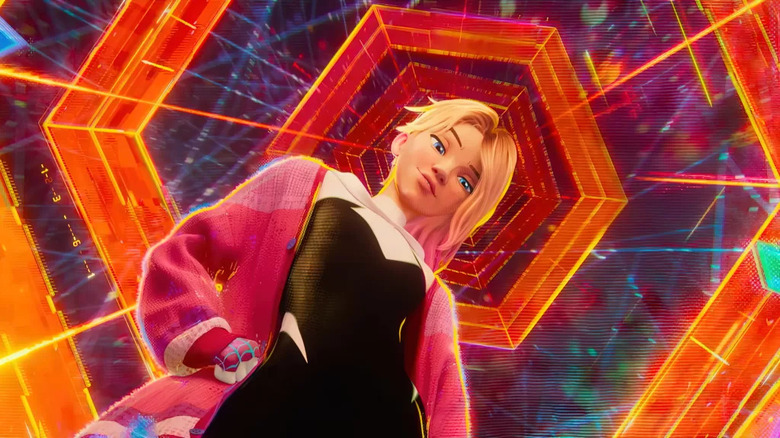Spider-Man: Across The Spider-Verse Makes Gwen's Story Just As Important As Miles
This article contains spoilers for "Spider-Man: Across the Spider-Verse."
In our first introduction to the teenage Gwen Stacy in "Spider-Man: Into the Spider-Verse," she is a strong and confident member of the team that Miles Morales fights alongside. Although he is smitten with her, she's a tough nut to crack. Gwen remains emotionally distant from everyone after the loss of her best friend Peter Parker.
"Spider-Man: Across the Spider-Verse" digs deeper into Gwen's struggles that Miles can relate to. She wants to reveal her identity to her father, Captain Stacy, but he is hunting Spider-Woman because he believes she caused Peter Parker's death.
From the first scene, "Spider-Man: Across the Spider-Verse" makes it clear that Gwen's story is just as important as Miles' story. Her point of view even bookends the film. The dazzling "Spider-Man: Across the Spider-Verse" opens with Gwen banging out her frustrations on the drums while she introduces the audience to her beautiful, watercolor-style Earth-65 through sarcastic narration.
After Gwen exposes herself as Spider-Woman and Captain Stacy still tries to arrest her, her hesitant decision to join Miguel O'Hara's Spider-Society puts in motion the events that unfold in the rest of the movie. Gwen escapes to another universe because she cannot bear the loneliness and pain of her father turning against her; she wants to feel like she belongs somewhere. The tension between Gwen's duty to the Spider-Society (which she begins to have doubts about) and affection for Miles is the motor that keeps this entire artistic masterpiece running.
Standing on her own
Gwen's emotional breakdown with her father is a remarkable work of art that is the true linchpin of "Spider-Man: Across the Universe." When Gwen reveals her conflict between her superhero and civilian identity, the watercolors in the background turn from an angry red to a melancholy blue and run down the walls like the hot tears on Gwen's face. Gwen tells her father that much like his role as a police officer, she has a passion for helping others and standing up for her community. Everything snaps into a blinding white with colorful shapes when they finally reconcile and hug.
One of the previous standout scenes shows how Gwen's personal journey parallels Miles'. It's also a chance for the movie to take a breather from the frenetic action scenes. They hang upside down on a building overlooking the vast city skyline — the only place they feel safe enough to confess their inner feelings. Gwen and Miles are both young people struggling with grief and the idea that their fate — and the fate of others — is pre-determined by the canon. Gwen likes Miles, but in every other universe when she falls for someone, it doesn't end well. She believes that she's chained to a tragic destiny.
By the end of "Spider-Man: Across the Spider-Verse," Gwen regains her spunkiness and assembles her own team to rescue Miles. They have a special bond as teenagers who have to deal with such great power and responsibility, as well as the enormous risks and consequences their secret identity has on their loved ones. Gwen's emotional arc carries most of the film, and she's the one who builds our anticipation for the next Spider-Verse installment in the heroic final moments where she leads the charge to find her friend.
Breaking the canon
With the exception of the short-lived "Spider-Woman" series in the late 1970s, we've rarely seen a female version of the famous web-slinger on screen. In the comics, there are lots of interesting iterations of a female Spider-Man, like Peter Parker's daughter May Parker, or Mattie Franklin, an obsessive Spider-Man fan-turned-superhero.
The comics also have unforgettable female characters: the beloved Aunt May, villains like Black Cat and Lady Octopus, and girlfriends such as Mary Jane Watson or Betty Brant. In the live-action version adaptations, actors such as Rosemary Harris, Marisa Tomei, Kirsten Dunst, Emma Stone, and Zendaya deliver fantastic performances as these resilient, iconic women, but they are still just romantic or maternal figures that orbit around Peter's life.
The major theme of "Spider-Man: Across the Spider-Verse" is dismantling the canon. With Miles Morales, we've already broken away from the standard narrative of Peter Parker — which has been exhausted three different times on screen. By making Gwen Stacy just as important in this film, it gives young girls their own amazing Spider-hero to look up to. Gwen is tough and has an unrelenting tenacity. She is unafraid to express her teenage angst. But she's also soft and feminine, especially in her graceful, coordinated movements inspired by ballet dancing. She even wears pointe shoes.
Gwen Stacy is an inspiring character that shows young audiences that there's no right or wrong way to identify as a girl. Girls can like both ballet and punk rock. The only thing that matters is staying true to yourself and fighting for what you believe in. By having Gwen step into a lead role, "Spider-Man: Across the Universe" reinforces the idea that anyone can wear the mask, anyone can be the hero.


